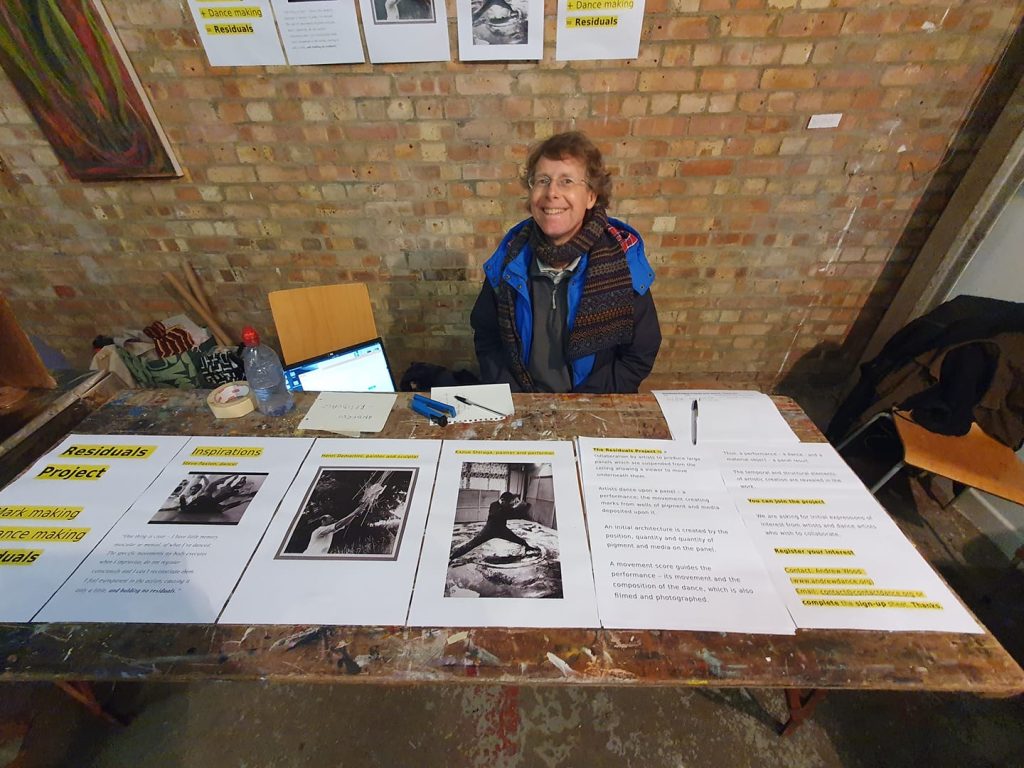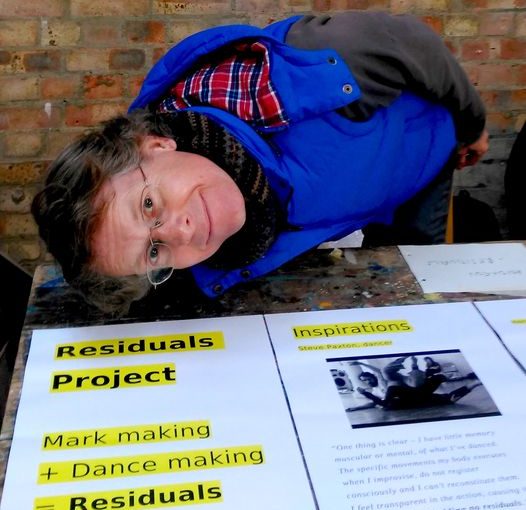I started a new dance project in April. Initially, I held a stall at the jumble sale of the Oxfordshire Visual Arts Development Agency and their Osney Mead studio space in Oxford. Read more about the project.
The idea of the residuals project could simply be described as body painting: using the body in motion, to create marks on a surface. Thus combining dance and mark making. I prefer ‘mark making’ to painting as it’s less about brushes and paint- there are none unless you consider the body as a brush, and more about the marks on a surface and the movement which creates it.
See the posters which I used on my OVADA jumble stall (PDF)

The stall allowed me to talk about the project and to invite people to participate or follow it. I hoping was to recruit dancers but I started an email list for it too.
Charcoal
Initially I expect to use charcoal powdered. It’s a black pigment but not in a medium like oils or acrylic for example. We could consider this as a ‘charcoal drawing’, and that the body is drawing the pigment across the surface. When I say surface then I mean the surface of the floor – which might be paper, canvas or some other surface which records the mark making.
Charcoal is carbon which is crucial for all living things. It’s part of the carbon cycle, and given our concerns about climate change it’s now central to the move to ‘Net Zero’ and a low carbon economy. Charcoal is formed by burning wood in an atmosphere which is starved of oxygen. There is a traditional industry of coppicing wood and creating charcoal. But these days, we might want to bury it as a way of capturing and storing carbon rather than burning it and re-suspending the carbon! Thus carbon is seen as central to all life and its use in the project is deeply symbolic.
All about surface
Contact improvisation is a dance which is all about surface! I examined this in my essay about dancing as sculpting (Dance as sculpture | dancing as sculpting | dancer as sculptor). Usually this is consider the surface of our body and those with whom we are dancing. But equally, there is the surface of the floor upon which marks and contact are deposited.
I recall a work by contact tango teacher Adriana Peoger where she dances Argentine tango in a sand pit. The sand recorded the movement of her tango shoes as she danced upon it, leaving lines and swirls – the imprint of her motion and shoes. I don’t recall if this was a solo or a duet dance.
Inspirations
Artists which you might know from body painting and similar practices are Yves Klein and Florence Peak. However, my inspirations are not those artists above but Steve Paxton, dancer; Hugo Demartini, artist and Kazuo Shiraga, artist and performer. Of course there is another inspiration: the dance and movement practice which we call contact improvisation.
Steve Paxton
When I transcribed the narration by dancer Steve Paxton of the film ‘Contact Improvisation 1972’ into captions then it ends thus:
The specific movements my body executes
when I improvise, do not register
consciously and I can’t reconstitute them.
I feel transparent in the action, causing it
only a little, and holding no residuals.
Steve Paxton, dancer from ‘Contact Improvisation 1972’ (time 00:08:48,700 – 00:09:04,000)
If – as Steve Paxton says – he holds no residuals then what are the residuals? The feeling in other people? The images and impressions made on a camera for film or photography? The movement of light recorded on an instrument, and one that presents as an image. But recall, that our sight is only one sense that we possess.
The proposition which I make, is that the residuals are recorded as marks on a surface which we might call a drawing or a painting. Like our footprints in mud or dirt on a path.
Hugo Demartini
Hugo Demartini used chance in his work. He would throw sticks into the air and allow them to fall upon a canvas to create abstract compositions which he painted. While we think of him as an artist – a fine artist, we could equally remember him for his performances which are recorded in photographs. I created a tribute performance to him and his work called Remembering Hugo Demartini, artist.
Kazuo Shiraga
Kazuo Shiraga was a painter and a performer. He is remembered as a member of the Gittai group in Japan for his paintings which he created with his feet. He would swing on a rope to assist his mobility in the slippery paint set on a canvas laid on the ground. It’s notable how this rope device also created an axis for his movement and contributed to the work’s motif.
Next steps
Having set an agenda, I now need to find a venue for the performance. I should create a solo piece with charcoal on paper. I need to consider how the ‘dance floor’ or surface for mark making – ‘a canvas’ is constructed. The technical and practical aspects need to be piloted before inviting others to participate in dancing together. One step as a time!
